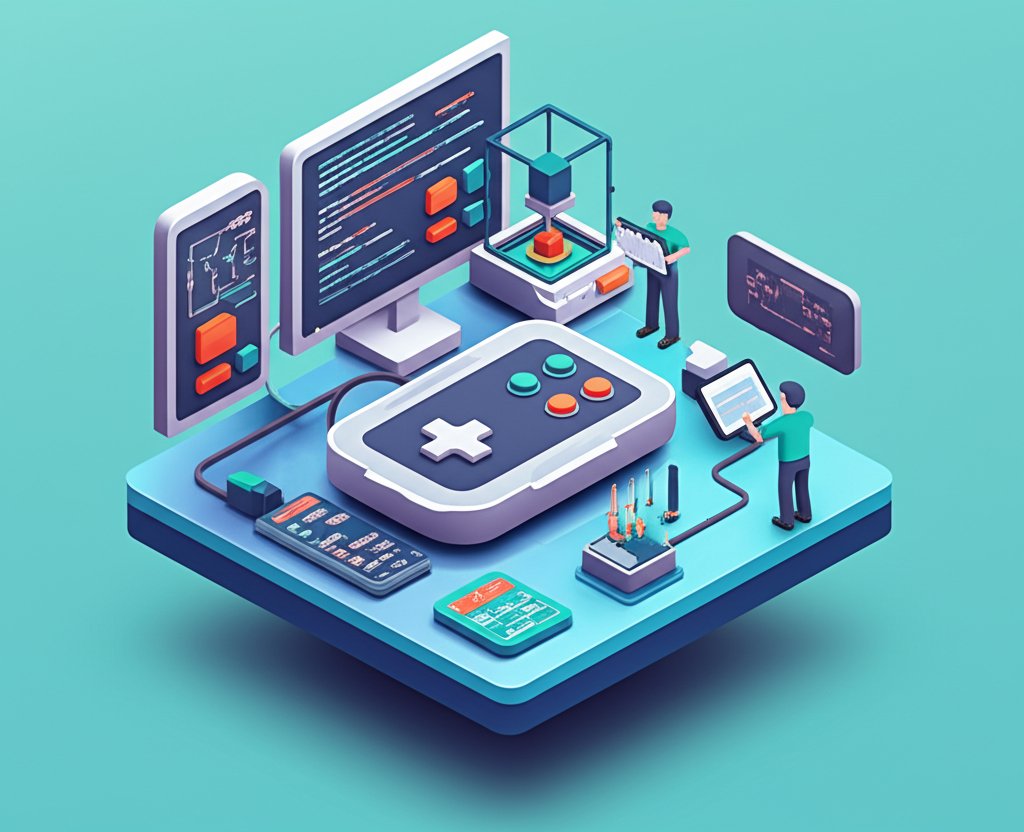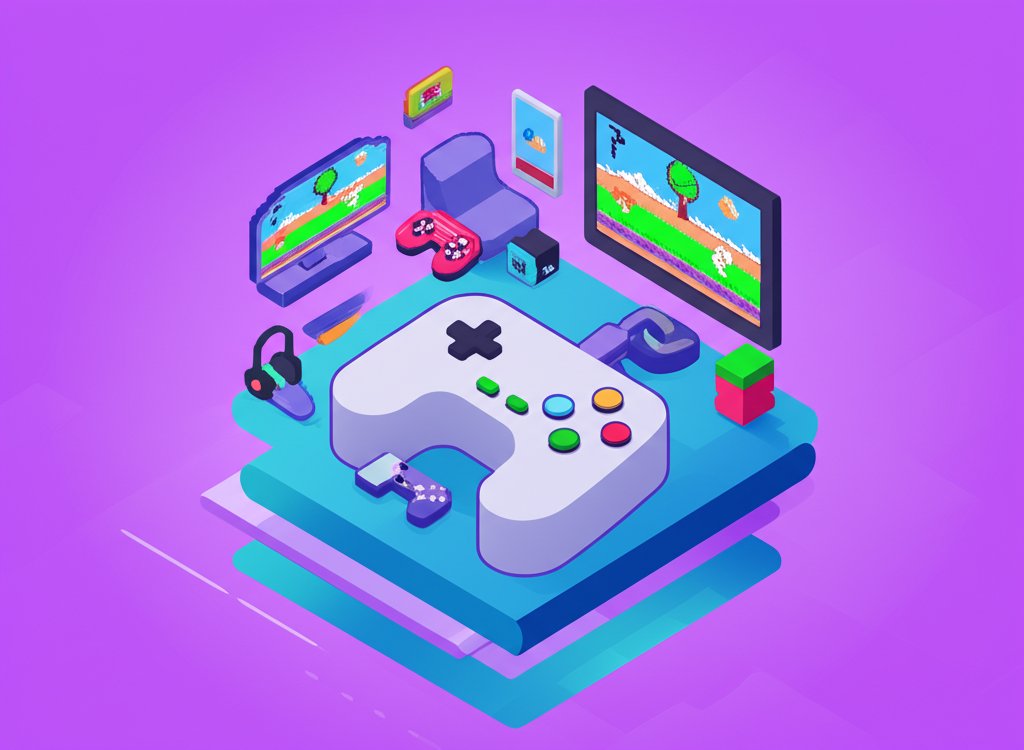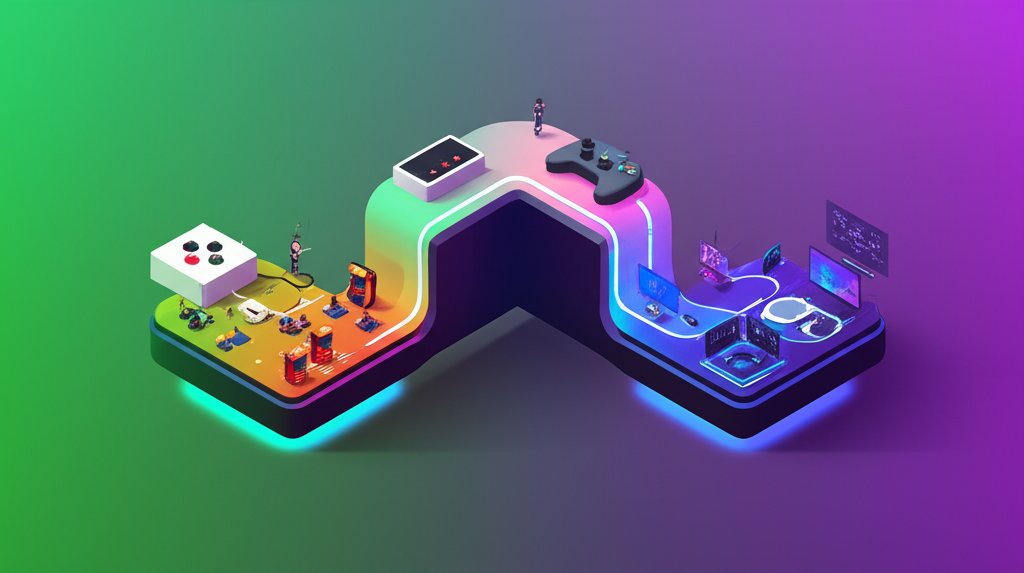Embark on an extraordinary journey through the captivating world of Home Console Development. From rudimentary pixelated adventures to today’s hyper-realistic virtual realms, home consoles have consistently redefined interactive entertainment, pushing the boundaries of what’s possible in digital play. This article will delve into the profound impact of game console development on creating unparalleled immersive experiences and driving relentless gaming innovation, exploring its past, present, and future trajectory. Prepare to understand the intricate technical artistry and strategic vision that ignites the future of gaming.
The Genesis of Home Console Development: A Historical Journey

The story of home console development is a saga of relentless ambition, technological breakthroughs, and fierce competition. What began as simple electronic diversions has blossomed into a multi-billion dollar industry, fundamentally shaping how we interact with digital worlds.
Understanding the evolution of home consoles requires appreciating the broader context of game creation, which is why exploring the history of game design can offer valuable insights into the creative processes involved.
Pioneering Eras: From Pixels to Polygons
The journey of home consoles began in the early 1970s, laying the groundwork for all gaming innovation to come:
- First Generation (1972-1983): The Magnavox Odyssey and the iconic Atari 2600 introduced electronic gaming into living rooms, featuring basic graphics and rudimentary gameplay. This era established the foundational concept of a dedicated home gaming device.
- Second Generation (1983-1990): Despite the video game crash, the Nintendo Entertainment System (NES) and the Sega Master System brought cartridge-based games, significantly improved graphics, and richer soundscapes, rekindling the market and proving the longevity of
home consoles. - Third Generation (1990-2000): A golden age, ushered in by the Super Nintendo Entertainment System (SNES) and the revolutionary Sony PlayStation, introduced 16-bit graphics, CD-ROM technology, and the advent of 3D polygons. This shift was a monumental leap in
game console development, enabling more complex and visually engaging worlds. - Fourth Generation (2000-2006): The Microsoft Xbox, Sony PlayStation 2, and Nintendo GameCube solidified online multiplayer gaming, delivered even more stunning graphics, and greatly expanded storage capacities, setting new standards for
immersive experiences. - Fifth Generation (2006-2012): The Sony PlayStation 3, Microsoft Xbox 360, and Nintendo Wii revolutionized interaction with Blu-ray technology, high-definition graphics, and the widespread adoption of motion controls, transforming casual gaming and expanding the audience for
home consoles. - Sixth Generation (2012-Present): With the Sony PlayStation 4, Microsoft Xbox One, and Nintendo Switch,
home console developmentcontinues to push boundaries with enhanced graphics, burgeoning virtual reality support, and robust game streaming capabilities, constantly evolving the landscape ofgaming innovation.
Driving Forces Behind Evolution
Several key factors consistently propel home console development forward:
- Technological Advancements: Miniaturization of components, increasing processing power (CPUs and GPUs), greater memory, and faster storage solutions are the bedrock of every new console generation. These advancements directly enable more complex physics, detailed graphics, and expansive game worlds, leading to richer
immersive experiences. - Market Competition: The intense rivalry between console manufacturers (Sony, Microsoft, Nintendo) is a powerful catalyst. Each company strives to outperform the others with unique hardware features, exclusive game libraries, and innovative services, fueling continuous
gaming innovation. - Consumer Expectations: Gamers continually demand cutting-edge graphics, more realistic gameplay, deeper narratives, and a wider variety of games. This relentless demand puts pressure on developers and manufacturers to innovate, ensuring
home consolesremain at the forefront of interactive entertainment.
Under the Hood: Key Pillars of Modern Game Console Development
Modern game console development is a highly specialized craft, demanding a deep understanding of hardware, software, and the intricate balance between performance and visual fidelity.
Hardware Optimization & Performance Metrics
Unlike the open architecture of PCs, home consoles are closed systems with fixed specifications, making optimization a critical skill in game console development.
- Console-Specific Hardware Architectures: Developers must leverage custom-designed System-on-Chip (SoC) solutions, such as AMD’s APUs found in PlayStation and Xbox, which integrate CPU and GPU for optimal performance. Understanding these nuances is paramount.
- Graphics and Audio Optimization: Achieving stunning visuals and pristine audio while adhering to a console’s specific hardware limitations is a constant challenge. This involves:
- Texture Optimization: Efficiently compressing and streaming textures to minimize memory usage without sacrificing visual quality.
- Level of Detail (LOD): Creating multiple versions of assets that are rendered based on their distance from the camera, reducing rendering complexity for distant objects.
- Shader Optimization: Streamlining the complex calculations that define how light interacts with surfaces to reduce GPU load and improve frame rates.
- Audio Compression: Optimizing audio files to reduce disk space and loading times while maintaining high fidelity for truly
immersive experiences.
- Maintaining Consistent Frame Rates: A stable and high frame rate (e.g., 60 frames per second) is crucial for smooth gameplay and player responsiveness. Developers meticulously profile and optimize their code and assets to ensure performance consistency across all
home consoles, regardless of the scenario.
The Development Toolchain & Best Practices
A robust development toolchain is the backbone of efficient game console development, providing the necessary resources to translate creative visions into playable games.
- Software Development Kits (SDKs): Console manufacturers provide proprietary SDKs that include powerful tools, libraries, and APIs specifically designed to interact with the console’s unique hardware and software environment. These are essential for accessing graphics processors, storage, and input devices efficiently.
- Integrated Development Environments (IDEs): Tools like Visual Studio or even custom console-specific IDEs are used for coding, debugging, and profiling games, offering streamlined workflows for developers.
- Version Control and Asset Pipelines: Professional
game console developmentrelies heavily on version control systems (e.g., Git, Perforce) to manage codebase changes and robust asset pipelines that automate the processing and integration of art, audio, and other game assets. - Collaboration and Industry Standards: Successful development teams embrace collaboration tools and adhere to industry best practices, including rigorous code reviews, thorough documentation, and continuous integration/delivery pipelines. Knowledge sharing and staying updated on the latest advancements are vital for
gaming innovation.
Shaping User Interaction: UI/UX and Accessibility
Crafting a welcoming, intuitive, and accessible user experience (UX) and user interface (UI) is paramount for home consoles, ensuring immersive experiences for all players.
- Designing for Gamepads and Controllers: Unlike PC gaming,
home consolesprimarily rely on controllers. UI/UX design must account for button layouts, stick sensitivities, and haptic feedback, making navigation and gameplay feel natural and responsive. - Prioritizing Accessibility: Inclusive design is not just ethical; it broadens the audience. Adhering to standards like WCAG (Web Content Accessibility Guidelines) in menu design, text legibility, color contrast, and control remapping ensures usability for diverse abilities. This includes:
- Assistive Technologies: Supporting features like screen readers, high-contrast modes, and customizable subtitles.
- Adaptive Controllers: Designing for compatibility with specialized input devices that cater to a wide range of physical needs.
- Cognitive Accessibility: Ensuring menus and tutorials are clear, concise, and easy to understand for players with cognitive disabilities.
- Benefits of Inclusive Design: Accessible UIs generally lead to better overall user experiences for everyone, fostering a more robust and diverse gaming community. It’s a critical aspect of modern
gaming innovation.
Crafting Unforgettable Worlds: Immersive Experiences & Gaming Innovation
The ultimate goal of home console development is to transport players into captivating digital realities, fostering profound immersive experiences through constant gaming innovation.
Pushing Visual and Auditory Boundaries
Advancements in fidelity are a relentless pursuit in home console development, driving new levels of immersion.
- Hyper-Realistic Graphics: Modern
home consolesleverage technologies like real-time ray tracing for incredibly lifelike lighting, reflections, and shadows, alongside 4K resolution and High Dynamic Range (HDR) for stunning visual depth and vibrant colors. - Spatial Audio and Haptic Feedback: Sophisticated audio engines, combined with 3D spatial audio, allow players to pinpoint sounds in a virtual space, enhancing environmental awareness. Haptic feedback, exemplified by controllers like Sony’s DualSense, provides nuanced tactile responses that simulate in-game actions, adding another layer to
immersive experiences. - Dynamic Environments: Advanced physics engines and environmental rendering techniques create dynamic worlds where player actions have visible consequences, from destructible environments to realistic weather systems.
New Play Paradigms & Interactive Technologies
Gaming innovation often stems from integrating emerging technologies into the home console ecosystem, creating novel ways to play.
- Virtual Reality (VR): While still niche, consoles like PlayStation have embraced VR with dedicated headsets, offering truly deep
immersive experiencesthat transport players directly into game worlds. Futurehome console developmentwill likely expand VR integration. - Augmented Reality (AR): Nintendo has experimented with AR, blending digital elements with the real world through camera-based gameplay. This technology holds untapped potential for unique interactive scenarios on
home consoles. - Advanced Motion Controls: Building on the legacy of the Wii, modern
home consolesutilize more precise motion tracking and gyroscopic sensors to offer intuitive and engaging control schemes for specific game types, contributing togaming innovation. - Artificial Intelligence in Game Design: AI is no longer just for enemy behavior. It’s used for procedural content generation, adaptive difficulty, dynamic storytelling, and creating believable non-player characters (NPCs) that enhance the feeling of a living, breathing game world.
Community, Connectivity, and Persistent Worlds
The evolution of home consoles has transformed gaming from a solitary pastime into a connected social experience.
- Robust Online Multiplayer: High-speed internet and sophisticated networking infrastructure enable seamless competitive and cooperative multiplayer experiences, fostering vibrant online communities.
- Game Streaming and Cloud Integration: Cloud gaming services and direct game streaming capabilities allow players to access vast libraries of games without needing to download them, reducing reliance on local storage and offering greater flexibility across
home consoles. - Live Service Games: Many modern titles are designed as “live services,” continuously updated with new content, events, and features, keeping players engaged over extended periods and creating persistent, evolving game worlds.
Navigating the Landscape: Challenges and Strategic Approaches
Despite the triumphs, home console development is fraught with significant challenges that require strategic foresight and substantial investment.
Overcoming Technical and Financial Hurdles
The sheer scale and complexity of bringing a new console or a high-end game to market are formidable.
- High Development Cost: Designing, manufacturing, and marketing a new
home consolerequires billions in R&D and production. Similarly, developing AAA games for these platforms can cost hundreds of millions of dollars, demanding massive financial backing. - Complexity of Hardware/Software Synergy:
Game console developmentinvolves an intricate dance between hardware and software. Ensuring optimal performance, stability, and compatibility across a console’s ecosystem is incredibly complex, requiring expert engineers and extensive testing. - Long Development Cycles and Time Constraints: Console generations typically last 6-8 years, with individual game development cycles often spanning 3-5 years. Meeting strict release deadlines while maintaining quality is a constant pressure, especially given market expectations for polished products.
Market Volatility and Consumer Demands
The gaming industry is dynamic and unpredictable, challenging home console manufacturers and developers to stay agile.
- Rapid Technological Shifts: While consoles are fixed hardware for a generation, underlying technologies (AI, VR, cloud) evolve rapidly. Integrating these without overhauling existing hardware presents a constant design challenge for
gaming innovation. - Fickle Consumer Preferences: Gaming trends can shift quickly. What’s popular today might be outdated tomorrow, requiring developers to anticipate future desires while making long-term investments in
game console developmentand uniqueimmersive experiences. - Rigorous Certification Processes: Before a game can be released on
home consoles, it must pass stringent certification tests set by manufacturers. These ensure quality, performance, and adherence to platform standards, adding another layer of complexity and time to the development timeline.
The Horizon: Future Trends Igniting Home Console Development
The future of home console development promises even more radical transformations, driven by converging technologies and evolving player expectations for immersive experiences and gaming innovation.
Cloud Gaming and Device Agnosticism
The shift towards cloud-based gaming services could redefine the very concept of home consoles.
- Hardware Agnostic Gaming: Cloud gaming platforms (e.g., Xbox Cloud Gaming, PlayStation Plus Premium, GeForce Now) stream games directly to any internet-connected device, potentially reducing the need for powerful local
home consoles. This model emphasizes access and subscription over hardware ownership. - Scalability and Accessibility: Cloud infrastructure offers unprecedented scalability, allowing developers to create games with immense computational demands that would be impossible on a single local console. This also democratizes access to high-end gaming.
Hyper-Realistic Graphics and AI-Powered Worlds
The pursuit of realism and intelligence within game worlds will continue unabated.
- Photorealism and Beyond: Continuous advancements in rendering techniques, neural graphics, and even more powerful dedicated hardware will push visual fidelity to near-indistinguishable levels from reality, providing ultimate
immersive experiences. - Advanced AI for Dynamic Worlds: Future
home console developmentwill see AI powering even more reactive, procedural, and intelligent game worlds. NPCs will learn and adapt more convincingly, stories could dynamically generate based on player choices, and environments might change in response to persistent actions, fostering unheard-of levels ofgaming innovation.
Blurring Realities: VR, AR, and Beyond
The line between the physical and digital worlds will become increasingly blurred in future home console gaming.
- Mainstreaming VR/AR: As VR headsets become more affordable, comfortable, and integrated, they are poised to become standard accessories for
home consoles, offering new dimensions ofimmersive experiences. AR could also find its place through mixed-reality peripherals. - New Sensory Feedback Systems: Beyond haptics, research into olfactory (smell) and even gustatory (taste) feedback systems could eventually integrate into gaming, offering truly multi-sensory
immersive experiencesand representing the pinnacle ofgaming innovation. - Brain-Computer Interfaces (BCI): While speculative, BCIs represent the ultimate frontier in
game console development, allowing direct thought-to-action control, offering unparalleled immersion and accessibility.
Conclusion
The evolution of home console development is a testament to human ingenuity and an insatiable desire for captivating entertainment. From the simple joys of early pixel art to the complex, hyper-realistic worlds of today, home consoles have consistently delivered groundbreaking immersive experiences and driven profound gaming innovation. The journey is far from over, with the horizon promising even more astonishing technological leaps. As developers continue to harness cutting-edge hardware and software, the future of gaming on home consoles will remain a dynamic, thrilling, and endlessly creative frontier, continuing to ignite our imaginations and shape how we play.
FAQ

Q1: What defines a “generation” in home console development?
A1: A “generation” in home console development typically refers to a period where a set of consoles share similar technological capabilities and compete directly. It’s usually marked by significant advancements in hardware (CPU, GPU, memory), graphical fidelity, and new features like online connectivity or motion controls, driving gaming innovation.
Q2: How do console manufacturers support game developers in game console development?
A2: Console manufacturers provide comprehensive support through Software Development Kits (SDKs), specialized development hardware (devkit units), extensive technical documentation, and dedicated developer support teams. They also oversee certification processes to ensure games meet quality and performance standards for home consoles.
Q3: What are the biggest challenges in modern home console development?
A3: Key challenges include the immense cost of R&D and game production, the technical complexity of optimizing for fixed hardware, long development cycles with strict deadlines, navigating rapid technological shifts, and meeting ever-increasing consumer expectations for immersive experiences and high fidelity.
Q4: How do home consoles create immersive experiences for players?
A4: Home consoles create immersive experiences through powerful graphics processing (e.g., ray tracing, 4K HDR), advanced sound design (spatial audio), haptic feedback in controllers, and the integration of technologies like virtual reality. These elements combine to engage multiple senses and draw players deeper into game worlds.
Q5: What role does AI play in future gaming innovation on consoles?
A5: In future gaming innovation for home consoles, AI will move beyond simple enemy behaviors to power dynamic and adaptive game worlds, procedural content generation, intelligent NPCs, personalized gameplay experiences, and even aid in the development process itself, leading to richer immersive experiences.
Q6: Why is accessibility important in home console design and game console development?
A6: Accessibility in home console design and game console development ensures that games are usable and enjoyable by the widest possible audience, including players with disabilities. It fosters inclusivity, enhances the overall user experience for everyone, and aligns with ethical and often legal standards, promoting broader gaming innovation.










